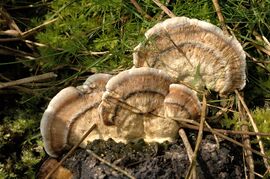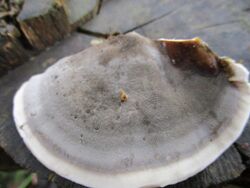Biology:Bjerkandera adusta
| Bjerkandera adusta | |
|---|---|

| |
| Scientific classification | |
| Domain: | Eukaryota |
| Kingdom: | Fungi |
| Division: | Basidiomycota |
| Class: | Agaricomycetes |
| Order: | Polyporales |
| Family: | Meruliaceae |
| Genus: | Bjerkandera |
| Species: | B. adusta
|
| Binomial name | |
| Bjerkandera adusta (Willd.) P.Karst. (1880)[1]
| |
Bjerkandera adusta, commonly known as the smoky polypore or smoky bracket,[2] is a species of fungus in the family Meruliaceae. It is a plant pathogen that causes white rot in live trees, but most commonly appears on dead wood. It was first described scientifically as Boletus adustus by Carl Ludwig Willdenow in 1787.[3] The genome sequence of Bjerkandera adusta was reported in 2013.[4] The species is inedible.[5]

Description
The fungus grows in shelflike fruit bodies which often overlap. The caps are tomentose to hairy and buff in colour.[6]
The species is often found on decaying wood.[6]
Bjerkandera fumosa is similar; its flesh has a dark line near the base of the tubes. Some members of the genera Stereum and Trametes are similar as well.[6]
Chemistry
Because Bjerkandera adusta produces enzymes that can degrade polycyclic aromatic hydrocarbons, such as those used in synthetic textile dyes, there has been research interest in investigating the fungus for possible use in bioremediation.[7][8] The research on these lignin-degrading enzymes produced by Bjerkandera adusta, such as versatile peroxidase, has also shown in studies to be able to decolorize synthetic melanin. This feature may allow Bjerkandera adusta to be utilized for melanin decolorization in future cosmetic applications. [9]
References
- ↑ Karsten, P. (1879). "Symbolae ad mycologiam Fennicam. VI" (in Latin). Meddelanden Af Societas Pro Fauna et Flora Fennica 5: 15–46.
- ↑ Ostry, M.E.; O'Brien, J.G.; Anderson, N.A. (2011). Field Guide to Common Macrofungi in Eastern Forests and Their Ecosystem Functions. Government Printing Office. p. 31. ISBN 978-0-16-088611-9. https://books.google.com/books?id=MYUxDc1JAAcC&pg=PA31.
- ↑ von Willdenow CL. (1787) (in Latin). Florae Berolinensis Prodromus. p. 392.
- ↑ Ruiz-Dueñas, Francisco J.; Lundell, Taina; Floudas, Dimitrios; Nagy, Laszlo G.; Barrasa, José M.; Hibbett, David S.; Martínez, Angel T. (2013). "Lignin-degrading peroxidases in Polyporales: an evolutionary survey based on 10 sequenced genomes". Mycologia 105 (6): 1428–1444. doi:10.3852/13-059. PMID 23921235.
- ↑ Phillips, Roger (2010). Mushrooms and Other Fungi of North America. Buffalo, NY: Firefly Books. p. 317. ISBN 978-1-55407-651-2. https://archive.org/details/mushroomsotherfu0000phil.
- ↑ 6.0 6.1 6.2 Trudell, Steve; Ammirati, Joe (2009) (in en). Mushrooms of the Pacific Northwest. Timber Press Field Guides. Portland, OR: Timber Press. pp. 256. ISBN 978-0-88192-935-5. https://books.google.com/books?id=WevHvt6Tr8kC.
- ↑ Singh, R.; Eltis, L.D. (2015). "The multihued palette of dye-decolorizing peroxidases". Archives of Biochemistry and Biophysics 574: 56–65. doi:10.1016/j.abb.2015.01.014. PMID 25743546.
- ↑ Kadri, Tayssir; Rouissi, Tarek; Kaur Brar, Satinder; Cledon, Maximiliano; Sarma, Saurabhjyoti; Verma, Mausam (2017). "Biodegradation of polycyclic aromatic hydrocarbons (PAHs) by fungal enzymes: A review". Journal of Environmental Sciences 51: 52–74. doi:10.1016/j.jes.2016.08.023. PMID 28115152. http://espace.inrs.ca/id/eprint/5160/1/P3032.pdf.
- ↑ Baik, Jina; Purkayastha, Anwesha; Park, Kyung Hye; Kang, Taek Jin (Sep 2021). "Functional Characterization of Melanin Decolorizing Extracellular Peroxidase of Bjerkandera adusta". Journal of Fungi 7 (9): 10. doi:10.3390/jof7090762. PMID 34575800.
Wikidata ☰ Q531200 entry
 |

